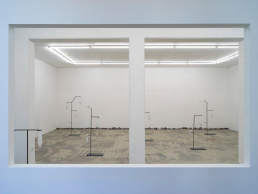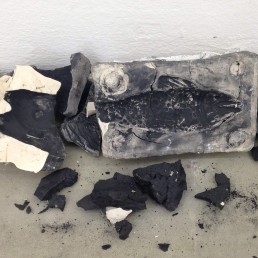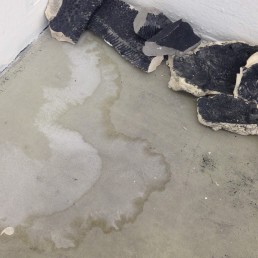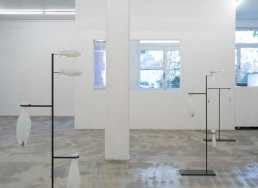It is said that people in Ancient Rome and Greece collected the tears they shed for those they mourned in tear vessels, or lacrymonies. For her first solo exhibition in Berlin at Klemm’s gallery, New York-based Elizabeth Jaeger (b. 1988) created what might be called an archeology of grief inspired by fish-shaped Roman tear vessels from the 2nd century BC.
Brine, the exhibition title, connotes a high-concentration salt solution in water. It is a substance used to preserve or to freeze, and it is also a by-product of industrial manufacturing processes. The word evokes associations of rotting, of emptiness, but also of transformation. Enter Jaeger’s glass fish vessels, effervescent, delicate yet confronting in the space.

Upon entering Klemm’s, a glassless window in the white partition separating the gallery space reveals a frame of her pieces – glass hand-blown fish, suspended in mid-air, at times fragile, at times brutal, at times almost something other than fish (I am reminded here of the little plastic bags that children carry their newly purchased goldfish home in, happily but violently shaking them around until they might already be dead by the time they reach home). The fish are vessels, otherworldly semi-transparent glass creatures hovering from dark steel constructions with little sharp copper teeth. Jaeger plays with horizontal and vertical lines, sometimes suspending fish horizontally in mid-air, but mostly letting them hang vertically by their tails, receptacles for anything that one could think to fill them with, both in a tangible and abstract sense.

Jaeger’s body of work explores the relationship between corporeality, perception, and consciousness, between sensation and emotion. She starts from her personal experiences, then conjures up a bigger picture that connects to the human condition and our current global issues. In this exhibition, a move away from working with the human form can be seen. Where previously, Jaeger worked a great deal with human bodies – naked women sculptures challenging the traditional male gaze, ceramic saddles in the shape of a female torso resembling the torsos of Ancient Greek and Roman sculptures – she has now moved towards the vessel as a mode of expression and connection to human existence and physicality in which she has perhaps found more freedom. Another piece by Jaeger, which stands separately from her Brine exhibition, also explores this freedom from the human form. It’s another vessel, this time large and rough, made from ceramic, blackened steel and magnetic sand. The title of the series it belongs to is Portrait of a Man (Jack Jaeger). A portrait of a man, as a vessel.
The pieces in Brine carry the graceful fluidity of fish, while simultaneously appearing as though frozen in ice. I am told that the fish contain salt solutions themselves, some more than others, drops that are in the slow process of crystallizing, which will eventually subtly taint and alter the semi-transparency of the fish bodies. Is this the salt of tears or the salt in the salt mines described by Stendhal, who likens the lover’s idealization of his object of desire to a twig thrown into the salt mines which emerges covered in salt crystals? But brine is found elsewhere too – on the edges of the floor, smeared in still corners of the white space, the artist has gently turned the entire gallery space into her salt-kissed world. Salt has eroded these edges of the floor, translating into something like the traces of a shipwreck for our time. The shipwreck continues all along the wall facing the entrance to the space, where the broken moulds which Jaeger used to hand-blow the glass fish in line the wall. Inversed fish faces stare up at you from the broken pieces.



Jaeger has built here an archeology of grief for today’s eyes, confronting the viewer with questions of urgency:
Which emptiness should you fill?
What will you shed tears for?
How do you choose to navigate the injustice of our power structures?
The vessels, their broken moulds and the salt eroding and crystallizing in the space reveal possible answers of strength through fragility.
— The exhibition runs from April 26 – June 8 2019 —

Gallery
Klemm’s
Opening year
2005
Opening Times
Tues – Sat
11-18
+49 (0) 30 40 50 49 53

